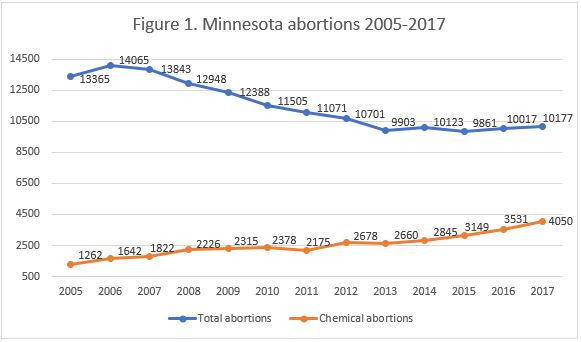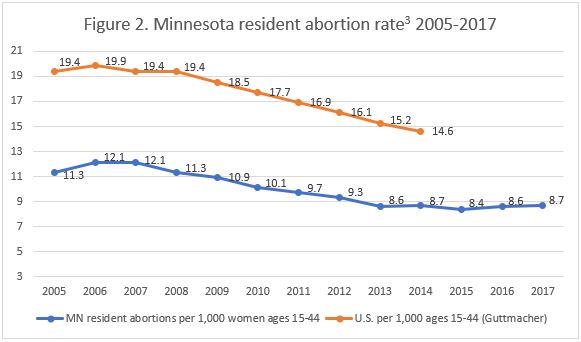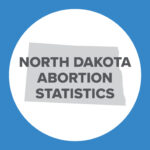Abortion Reporting: Minnesota (2017)

Note: In July 2019, the Minnesota Department of Health revised the 2017 abortion report to reflect the addition of abortion reporting forms that were received after the report had been published and the removal of abortion reporting forms that were incorrectly filed. There were 10,134 abortions in Minnesota in 2017, of which 4,015 were chemical abortions.
Minnesota’s annual abortion report for 2017 reveals that abortion in the state has risen slightly from the year before. Planned Parenthood’s abortion market share has increased by an even greater margin.
Statistics and Changes in Minnesota Abortions, 2016-2017

Abortion Totals and Trends
There were 10,177 abortions reported in Minnesota in 2017, a small increase of not quite two percent from the 10,017 reported1 in 2016 (Fig. 1). The totals for 2016 were revised from the initial 2016 report to account for late or corrected abortion reporting forms submitted to the Minnesota Department of Health after the 2016 abortion report had been finalized. Chemical abortions increased by an even greater percentage, rising 14 percent from 3,531 in 2016 to 4,021 in 2017. Since 1999, the first reporting year after Minnesota’s reporting statutes went into effect, abortions in the state have fallen by 29 percent. At the same time, chemical abortions have increased by more than a thousand percent since 2001, the first full year after the Food and Drug Administration approved the use of mifepristone as an abortion drug. In 2017, chemical abortions made up 40 percent of the state total. Minnesota’s resident abortion rate in 2017 was 8.7 abortions per 1,000 resident women of childbearing age, up from 8.6 the previous year (Fig. 2). This rate is below the national average as last reported by the U.S. Centers for Disease Control in 2014.
State Report Summary
Ninety-one percent of the abortions reported in Minnesota in 2017 were performed on Minnesota residents. Of the remaining abortions, 635 were performed on women from Wisconsin. More than half, 57 percent, of the women getting abortions were in their twenties. Eight percent were age 19 or younger, including 12 girls under the age of 15, while 31 percent were in their thirties and 4 percent were age 40 or older. White women made up the largest racial group, undergoing just over half of the abortions reported in Minnesota. Black women made up the next largest group at 26 percent. Twelve percent of the abortions reported in Minnesota were performed on women who had less than a high school education. Twenty-one percent had finished high school, and more than a quarter – 27 percent – had completed some college but had not yet graduated. Twenty-three percent had a college degree, and 17 percent did not report their level of education.
Similar to other states, the majority of women getting abortions in Minnesota were not married (79 percent). Fifteen percent were married, and five percent did not report their marital status. More than half had given birth before; 23 percent reported one previous live birth, and 36 percent reported two or more. Fifty-nine percent reported no previous abortions. Twenty-three percent of women reported one prior abortion, and 17 percent reported two or more. A large majority of 79 percent had never experienced a miscarriage, while 15 percent had had one miscarriage and five percent reported more than one.
Most abortions performed in Minnesota occurred early in pregnancy. Sixty-nine percent were performed at less than nine weeks of gestation, and 21 percent were performed between nine and 13 weeks. By contrast, six percent of Minnesota abortions occurred between 14 and 17 weeks, and two percent occurred between 18 and 20 weeks. There were 152 abortions performed after 20 weeks of gestation, or five months of pregnancy. The latest reported gestational age was 27 weeks, close to the end of the second trimester. Gestational age was not reported for 80 abortions.
Seventy-five complications were reported, occurring during or immediately after the abortion procedure2. More than one complication could be reported for a single patient. Nine cervical lacerations and one uterine perforation were reported, as well as eight instances of hemorrhage or heavy bleeding. Fifty-seven unspecified complications were reported. In addition to these, complications were identified and reported after patients had left the abortion facilities. Minnesota law requires that physicians who treat complications resulting from abortion report them to the state. In 2017, there were 49 post-operative reports detailing 57 complications. The most common of these post-operative complications was failed termination (continued pregnancy), occurring 16 times, followed by incomplete termination (retained products), which occurred 15 times. There were five hemorrhages or instances of heavy bleeding, four infections requiring inpatient treatment, two cervical lacerations, and one uterine perforation. Fourteen other complications were not specified.
Minnesota uses public funds to pay for abortions. In 2017, a total of 44 percent of all abortions performed in the state and 48 percent of the abortions performed on residents were paid for using public assistance, similar to the previous year. Thirty-two percent of all abortions were self-funded, and 24 percent were covered by private insurance.
Minnesota reports both the number of abortions performed in each abortion center in the state and the number of abortions performed in each type of facility. In 2017, five abortion clinics were operating in Minnesota, accounting for 10,071 abortions. Planned Parenthood was by far the highest-volume center, accounting for 61 percent of all abortions reported in Minnesota, up from 57 percent of the total the previous year. In addition, 10 independent physicians, small clinics, and hospitals together reported 106 abortions. Sixty-five physicians performed the total of 10,177 abortions reported in Minnesota during 2017. Sixty-eight percent of abortions were performed by doctors who specialized in obstetrics and gynecology, and 32 percent by doctors who specialized in general or family practice. Twelve abortions were performed by doctors who practiced emergency medicine.
Women undergoing abortions in Minnesota were asked to provide their reasons for choosing abortion. Women could select more than one reason. The most common answer, chosen by 7,174 women (70 percent), was that the mother “does not want children at this time.” The second most common reply was economic concerns, cited by 2,403 women or 24 percent of the total. Seventy-three women chose abortion due to rape, and seven because of incest. Forty-seven women had abortions because of a risk of impairment of a major bodily function of the woman.
At least 24 hours before undergoing an abortion in Minnesota, a woman must be informed of the medical risks of abortion as well as medical assistance and resources available to her, including the opportunity to view printed materials on the characteristics of the unborn child, fetal pain, and alternatives to abortion. In 2017, a total of 11,341 informed consent reports were received. There were 10,107 women who were known to have gone on to have an abortion, 90 who did not have an abortion, and 1,144 unknown. At least two women opted for perinatal hospice rather than abortion as a response to a fetal anomaly.
In 2017, a total of 2,634 of the babies killed by abortion were discarded using cremation, and 49 were buried. There were 7,447 who had not yet reached the level of development necessary to be considered fetal remains under the law, which the state defines as possessing “cartilaginous structures, fetal or skeletal parts.” The method of disposition was not reported for 47 abortions. The month of March had the most abortions, 10 percent, while November had the fewest, seven percent.
There were three babies born alive during abortions in 2017 compared to five the year before. None survived. One had a very low APGAR score and received no treatment. For the second, “comfort care measures were provided as planned.” For the third, no treatment was reported. The report does not state the gestational ages at which these infants were born.
Updates to Minnesota’s Reporting System
Minnesota’s abortion reporting is among the best in the nation, and the state continues to take steps to improve it further. Recently, the state revised its abortion reporting form to make it more consistent with the way demographic data is collected nationally. As one example, Minnesota’s form now has 16 different options that a doctor may select to record a woman’s race, compared to five on the old form, which allows for greater precision in reporting. The revisions to the form’s demographic data collection bring it in line with the Minnesota Department of Health’s birth, death, and fetal death records. The state also added more possible responses to the “method of disposal of fetal remains” section of the form, which will allow that section to be completed for each abortion, including those performed at early gestational ages. Additional questions were added to the abortion reporting form to bring it into compliance with the state’s 2015 Born Alive Infants Protection Act, which requires doctors to report whether a baby was born alive during an abortion; if yes, the treatment given to the baby; whether the baby survived; and the baby’s current status. As of March 2017, all abortions in Minnesota are reported through an online reporting system.
However, Minnesota now no longer collects information on women’s contraceptive usage and history because the national induced termination of pregnancy form does not collect these data. Minnesota’s experience underscores the importance of a comprehensive national reporting system that allows for consistency among the 50 states. Additionally, the state no longer collects the zip codes of women who get abortions because publication of these data could compromise the women’s confidentiality.
State Ranking
Minnesota’s annual abortion reports serve as proof that state reporting can be efficient, low-cost, and thorough. Ranked number two in the nation in 2016 by a CLI survey of abortion reporting across the 50 states, New York City, and Washington D.C., Minnesota releases its reports on a regular, annual schedule. In 2017, Minnesota’s report once again cost only $4,000 to produce, including printing costs. Minnesota is a transparent state, reporting all the data points it collects. However, the North Star State still has room for improvement. Minnesota could collect and report information on its parental notification process as some other states do. In addition, because abortion in Minnesota is prohibited after viability, the state could report whether any babies were viable and if so, why the abortion was necessary. Overall, though, Minnesota’s consistent reporting stands as a model for the rest of the nation.


- Due to late or revised abortion reporting forms, abortion totals for 2016 were updated after the 2016 report was published.
- Statistics on abortion complications reported here represent a minimal number of deaths and complications, as this data is collected in a non-systematic and non-verifiable way. As such, this data cannot be used to calculate either an accurate abortion mortality rate, nor an accurate abortion complication rate for the state.
- According to Minnesota’s 2017 abortion report, the 2017 rate was calculated using 2016 population estimates. The rate reflects the number of abortions performed on Minnesota residents per 1,000 resident women ages 15-44.
Click here to view reporting from:2023202220212020201920182016





















